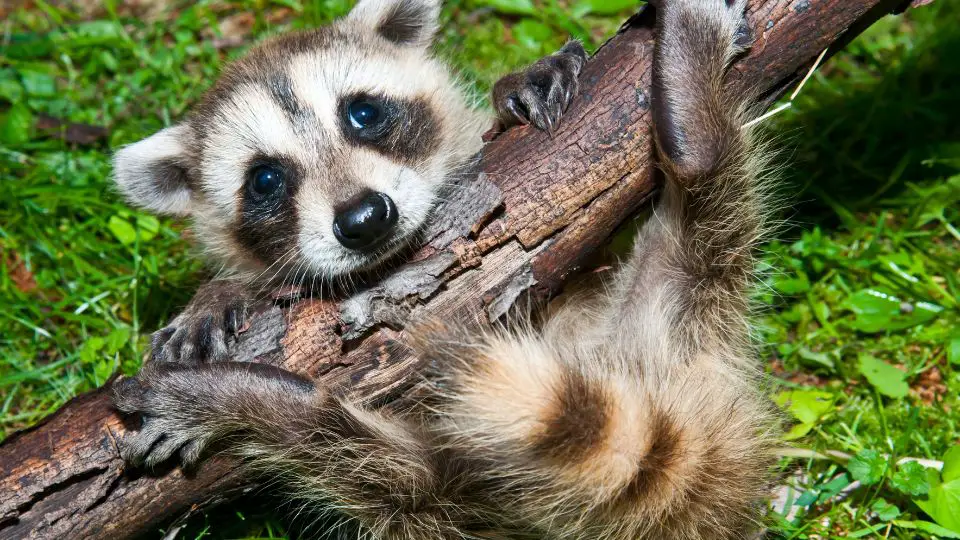Raccoon footprints are about two to three inches in diameter. Each paw print is usually about one to three inches long.
Table of Contents
What do raccoon prints look like?
The size of the raccoon affects how large the prints will be. A normal-sized raccoon will leave a print about the size of a quarter coin. They register five narrow and long toes in both front and rear feet.
Raccoons also usually register small claws above each toe. A thumbprint is not seen, but the fingers on either end of the paw are shorter than the rest.
On the front track, their toes appear broader and more spread out than the toes on the hind track. This is ironic since their hind feet are technically bigger than the front.
Their hind feet can be about two to four inches long and one to three inches wide. Raccoons front feet can be about one to three inches long and one to three inches wide.
The front and hind paw prints look similar, but the hind paw prints display elongated heel pads that sink deep into a soft surface such as mud. The hind feet also register a larger palm than the front feet.
Their foot pad can be compared to the shape of the letter C. The heel is shown on the back prints because of how raccoons walk, known as their gait. Raccoons walk with the majority of their body weight on their back end.
This gait also causes the front and hind paws to appear side by side or slightly offset from each other in their prints. The step lengths in raccoon gaits vary from about ten to eighteen inches. Raccoon prints might appear farther apart if they were loping.

How many fingers and toes do raccoons have?
Raccoon paws have five fingers and toes, so their prints often look like the handprints of a human child. The similar appearance to that of a human hand makes their tracks easier to identify than most animal tracks.
All four feet on raccoons have five fingers and toes that are long and narrow. Their claws are also long. Raccoons don’t have thumbs as humans do, but they use two dexterous forepaws to lift and grasp objects. This inner toe and outer toe are smaller than the other toes.
What about baby raccoon tracks?
Baby raccoons do not leave their den until they are eight to twelve weeks old, so newborn raccoon prints are often not seen. Baby raccoons begin walking within the den at six weeks, so until they leave the den, their tracks will only be found there.
If there are several sets of tracks together, this gives a clue that a mother raccoon and her babies left the tracks. Raccoons are solitary creatures and usually are only together if they are with their young.
Baby raccoons stay with their mothers for about six months. Tracks left by baby raccoons will be smaller than the prints of the adult raccoon, but the measurements will vary depending on how old the baby is.

What to do if you identify raccoon tracks?
Raccoons can be a hazard because of the diseases they may carry. These diseases, such as rabies and distemper virus, can be transmitted to humans and pets. Raccoons can also cause severe damage to your yard and home.
They are known to ruin flower beds, rummage through trash cans, and eat on bird feeders. Raccoons seek warmth and safety in homes by crawling through entryways.
They can also use their fingers and teeth to create access points to your home. Homeowners can experience raccoons in their attics, chimneys, and garages.
Raccoons will not leave without intervention. If you have found tracks of a raccoon in your yard or near your property, you should take immediate action. Raccoon tracks are often accompanied by raccoon scat found nearby.
Below are some tips to repel these destructive critters:
Natural Repellents
Use homemade remedies using ammonia, vinegar, cayenne pepper, garlic flakes, and blood meal. These are natural deterrents since they will emit smells that raccoons dislike.
Create your own spray by mixing water, dish soap, and hot sauce. This can be sprayed in areas where you have noticed raccoon activity.
You can also try installing motion sensor lighting and motion-activated sprinklers.
Landscaping
Keep a clean yard with trimmed vegetation. If your yard is overgrown, raccoons will be attracted to the hiding spots it provides.
Also, remove any food sources such as pet food or bird seed. You can purchase a pest-free bird feeder that will keep out raccoons, squirrels, and chipmunks.
Property Management
Tightly secure your trash cans. Scented garbage bags with essential oils like mint are also a great way to keep raccoons out of your trash.
Seal all access points into your home or property, such as cracks and holes. Contact a wildlife professional to help you catch and remove the raccoons that may have taken up residence in your home or business.

No action should be taken if you find raccoon tracks in an area such as a forest or park. Raccoons are nocturnal, so they likely left footprints while moving or foraging for food.

